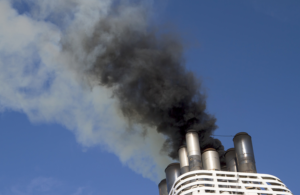The Charity
Aviation
Maritime
Air Emissions alongside – boiler flame failures

Initial Report
Two reports highlighting issues with smoke emissions.
What the Reporter told us (1):
Our vessel, a tanker, was discharging her cargo with all systems working normally. At 08:15 the auxiliary boiler “Flame Failure” alarm activated, and the boiler shut down. The engineers responded and attempted to restart the boiler on several occasions, without satisfactory results. At 09:25 and 10:50 the shore terminal warned the vessel that smoke had been observed emitting from the funnel. These times corresponded with the vessel’s attempts to restart the auxiliary boiler. Following this, the engineers removed the burner and replaced it with an overhauled spare. The auxiliary boiler was then started without any emissions being observed from the funnel and without any further impact to the vessel’s operation.
Examination of the removed burner showed that it was partially clogged. One month previously, the boiler had undergone a full test in the presence of a class surveyor. Prior to arrival at the port, all boiler pre-arrival checks had been undertaken with no problems noted. The burner had been subjected to routine overhaul two weeks prior to the incident. Additionally, the quality of the fuel was checked and found to be satisfactory.
It should be noted that the normal automatic operation of a boiler following a flame failure will result in smoke emissions, since the burner fan will start the purging cycle which removes any gases present in the furnace through the funnel. This process is important since it allows for the correct ratio of air to fuelwhen the boiler is reignited, (thus preventing a non-stoichiometric initial combustion with potential for drumming and/or firebox explosions).

Air Pollution (library image)
What the Reporter told us (2):
Shortly after our vessel departed port, increased smoke emission from the vessel’s funnel was observed. The bridge reported this to the engine control room. Simultaneously the alarm of the opacity monitor (high smoke) activated.
In response to the alarm, the engineers started No 2 boiler and stopped No 1 boiler to investigate the cause of the malfunction. During the investigation it was found that a fuel oil sensor was damaged. A new sensor was available on board and the defective one was replaced. As soon as the vessel was in open sea, boiler No1 was restarted and confirmed to be operating satisfactorily.
It was concluded that the excessive smoke generated was due to the damaged pick-up sensor. Specifically, due to the damage to the sensor, the amount of fuel supplied to the boiler for the required load was incorrect, which resulted in incorrect air/fuel ratio, incorrect combustion and the generation of excessive smoke.
It was noted that the sensor was supposedly maintenance free with replacement being condition- based. The malfunction of the sensor was discussed with the boiler manufacturers and advice was requested as to any measures required in order to prevent similar problems in the future. The manufacturer advised that there is no preventative maintenance for the sensors but suggested an upgrade of the existing fuel oil control system with a modern, more robust one, without moving parts. This is being implemented on all our vessels with this type of boiler.
CHIRP Comment:
Both reports highlight the importance of fuel combustion equipment maintenance in order to avoid air pollution. Ports are generally taking a more active role in advising vessels of excessive smoke emissions, and port state control is equally taking a greater interest in MARPOL Annex VI regarding NOx, SOx and particulate matter (PM) emissions.
Report Ends







